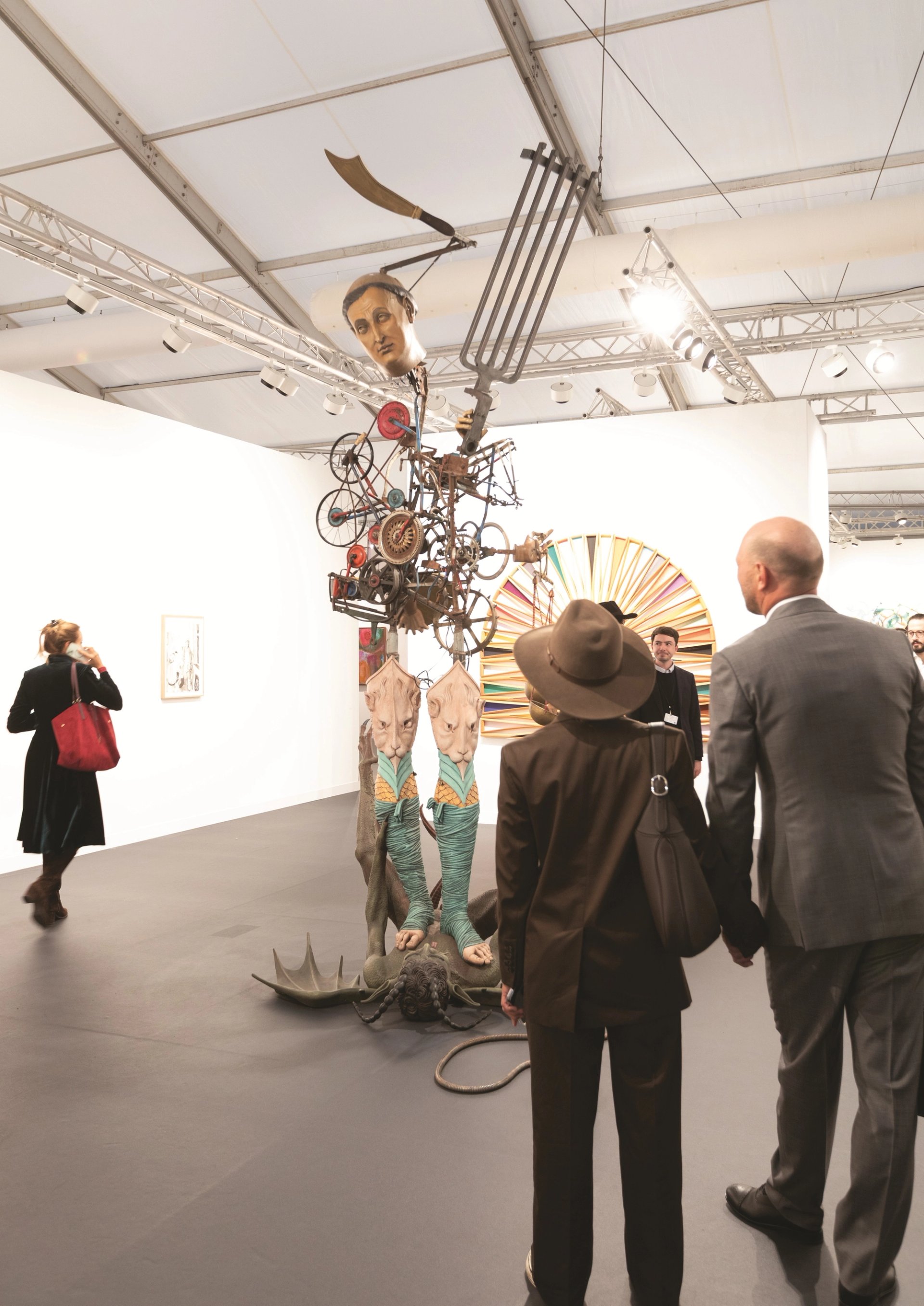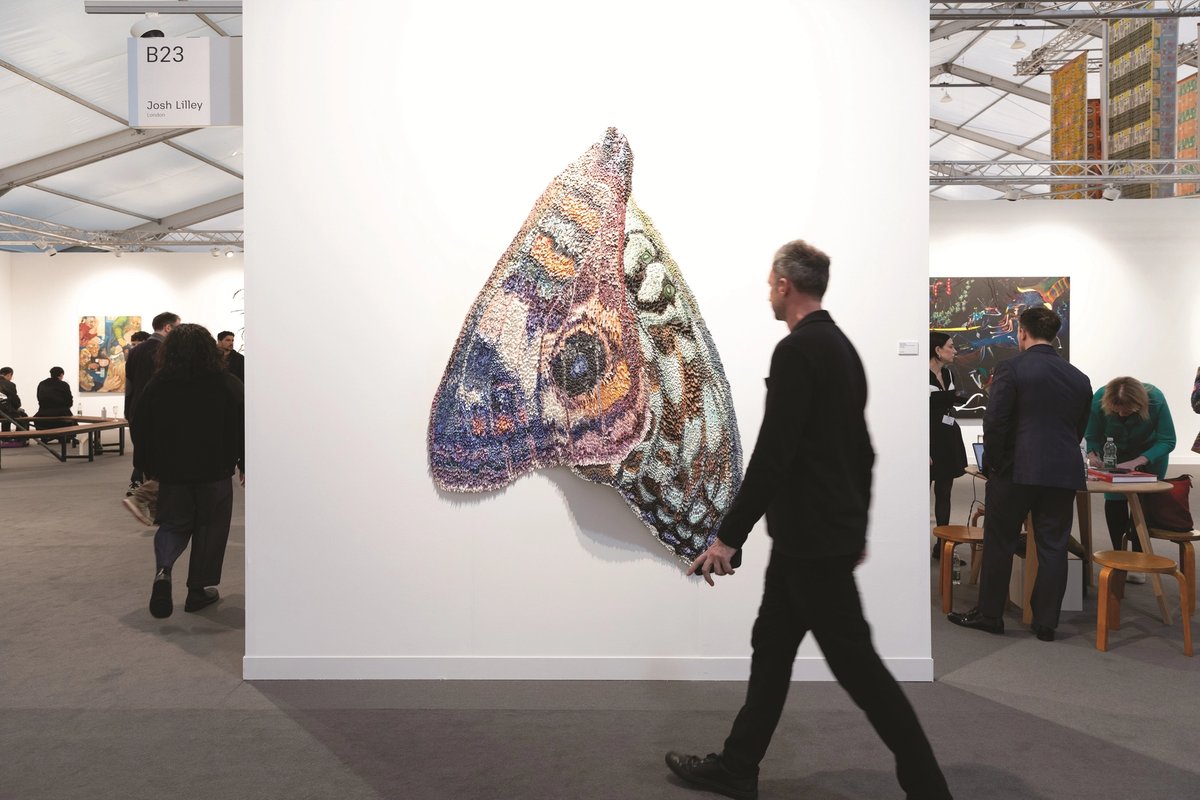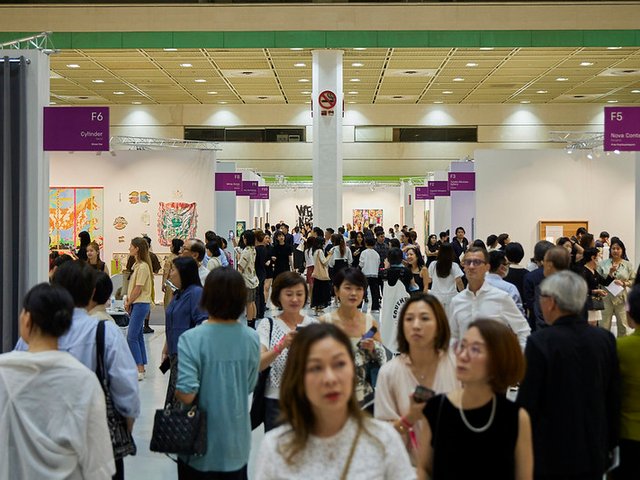Watching crowds come through the door, greeted by the younger, more experimental galleries of the Focus section, François Chantala, a partner at the London-based Thomas Dane Gallery, observes an energy in London this week: “People are coming to London, young galleries are springing up…someone was saying earlier that it feels a little bit like the 90s again.” The UK’s post-Brexit art market may face headwinds in the form of a faltering economy and wealth-deterring tax reforms, alongside broader geopolitical turbulence, but Londoners do well in adversity, Chantala thinks. “That’s what London does—it grows back from the rubble every time, it’s that Blitz spirit,” he says. The gallery’s first-day sales included Michael Landy’s Multi-Saint (2013)—which was bought by the Contemporary Art Society’s Collections Fund for the Walker Art Gallery in Liverpool—with an asking price in the region of €125,000.
“This is a confidence-based game,” says the London-based gallerist Josh Lilley. “The difference for me is pre-sales—there would have been more in years gone by, there was more urgency.” This year’s fair, he adds, “feels very much more localised, these [buyers] are people either in London or thinking about London”. But we must not mistake a lack of urgency for the lack of a market, he thinks. “A speculative market needs urgency because the notion is that prices are always rising,” Lilley says. “That’s what speculation is.” Now he notes a more considered approach: “You can call that patience, or perhaps realism…for quality, prices are still going up.” Lilley’s first-day sales included Egg, a crystalline painting by Gareth Cadwallader, for £85,000, and a Rebecca Manson porcelain wall sculpture for $85,000.

Thomas Dane Gallery sold Michael Landy’s Multi-Saint (2013) to the Walker Art Gallery in Liverpool through the Contemporary Art Society. Photo © David Owens
Magritte and Münter
By 5pm, Hauser & Wirth had sold around 17 works at Frieze London and another 16 at Frieze Masters, with higher prices for blue-chip Modern works at Masters—among them René Magritte’s Le domaine enchanté (1953) for $1.6m and Gabriele Münter’s The Blue Garden (My Garden Gate) from 1909, which sold for SFr2.4m ($3m), the highest reported sale at the time of writing. Sales at Frieze London included George Rouy’s gargantuan DESIRELINE II (2025) with an asking price of £275,000, and Avery Singer’s Lost Boccioni (2025), priced at $800,000.
Neil Wenman, Hauser & Wirth’s creative director, says the sales “talk for themselves…people have been asking ‘has Frieze Week changed?’, but actually, loads of people are here.” There has been some correction, he acknowledges: “Artists that were a bit overly commercial have faltered. But, ultimately, quality always rules, and if the work’s good, there’s never a problem in selling it,” he says.
Wenman agrees with Lilley that collectors are taking longer to make decisions. At the market’s high point a few years ago, it was, Wenman says, a “frenzy of people just saying, ‘I want that’, without interest in even knowing who the work was by. So, I think that’s actually quite good, that sense of actually learning a bit more about the work.”
Tax changes in the UK and the curtailment of non-dom status have reportedly caused some wealthy individuals to move out of London. So, is the Frieze collector pool poorer for it? Wenman surveys the stand: “I’m looking at two who’ve left because of non-dom changes, and they’re on this booth now, they’re buying…the fair gives them a reason to come back. Yes, it is different when the non-doms leave, of course, but they’re still collecting.”
Weaving some magic
Cecilia Brunson Projects, exhibiting for the first time in the main section of the fair, had sold six of the eight woven works by the Indigenous Wichí collective Claudia Alarcón & Silät it was exhibiting before the first hour of the fair was up. Prices for textiles, woven by the Argentinian collective of more than 100 women, ranged from $19,000 to $55,000. “The reception has been amazing,” Brunson says, adding that all works were sold to new clients, from Italy, Singapore and San Francisco.
Brunson adds that, against a backdrop of a “complicated” market globally, the work’s reception was “a positive surprise. I think it’s important that artwork has meaning, and in this case it’s about a community. It’s incredibly deep—socially, politically and spiritually. When all those things are combined, collectors are attracted to it.”
Shortly after opening, Lisson Gallery sold two paintings by Sarah Cunningham, the young artist who died last year aged 31. “One’s been placed with a very wonderful collector in the US, and the other one he’s buying as a gift for a museum in the US,” says Louise Hayward, a partner at Lisson Gallery. “We couldn’t think of anything better—he and the museum had done a studio visit with Sarah very shortly before her death, so it’s very meaningful to the collector and the museum curator.” The works were priced at $26,000 and $30,000.
On the broader art market, Hayward is sanguine: “Where there are bubbles in a market, things are corrected, then things plateau for a while, and then we’ll see bubbles in different parts of the world…it’s just cyclical.” Hayward adds that yesterday’s audience was more “business-focused” than in recent years: “It feels like they may have done a bit of an edit of the VIP list.”
Elsewhere, Thaddaeus Ropac sold a Robert Rauschenberg, Polls (1987), for $850,000, citing increased interest in the artist’s work due to the centennial of his birth this year. Ropac noted in a statement that the “market is starting to pick up somewhat after the past slow months”. Roshini Vadehra, the director of New Delhi’s Vadehra Gallery, also noted an unexpected uptick—the New Delhi-based gallery sold around half its stand at Frieze London and its almost entire stand at Frieze Masters. “We’ve had a better year than last, which is surprising, considering the news that’s coming out from this part of the world,” Vadehra says.
While much discussion has focused on gallery closures and the poor state of the art market, some younger galleries have only known leaner times. “I opened in Covid, so I’ve never known any different,” says Freddie Powell, the founder of London-based Ginny on Frederick, which is exhibiting in the Focus section. “We’re still young and nimble, so there hasn’t been this doomsday situation occurring for us.” On the opening morning, Ginny on Frederick sold Accounts (2025) by Alex Margo Arden, a roped cluster of decommissioned mannequins of industrial workers from the National Motor Museum, to the Arts Council Collection (works in the booth ranged between £20,000 and £30,000).



